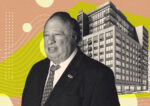Trending
The Daily Dirt: When will Manhattan’s flight to quality land?
Dwindling new construction holds promise for aging office buildings

New York real estate is not a monolith.
That’s especially true for Manhattan’s office sector, which has become a tale of the haves and the have nots. Last year was a banner year for the haves, as Manhattan saw a record of 192 leases at $100 per square foot or more.
The record is just the latest instance of a trend that’s taken hold in recent years. The flight to quality appears to be enough to break through skepticism around the office market’s recovery for developers to trudge along with building millions of square feet of new office space.
Of the biggest office projects nearing completion last year, the top five were all in Manhattan. That included Brookfield’s Two Manhattan West, Vornado Realty Trust’s Penn 2, SL Green’s One Madison Avenue, L&L and Columbia Property Trust’s Terminal Warehouse, and the “Googleplex,” the tech giant’s new space at 550 Washington Street.
Most of those office projects had been in the works well before the pandemic sent the sector on a downward spiral. For the most part, they seem to have been huge successes, reeling in headline-worthy lease signings from the likes of KPMG and MSG Entertainment.
As those pre-pandemic projects reach completion, New York’s office construction pipeline is all but empty. Almost everything that isn’t near the finish is being held at the starting line, with developers spooked by issues like oversupply and high building costs.
The One Vanderbilts and the Seagrams Buildings of the world are in a class of their own, but offices seeing tenants flee for top-notch properties are facing a more uncertain fate.
For those aging office buildings that haven’t already been earmarked for residential conversions, a dwindling supply of newer, shinier buildings could be their saving grace.
—
What we’re thinking about: The Columbia University professor who foretold New York City’s “urban doom loop” has changed his tune, citing revived tourism and improved return-to-office rates. Is he right to be optimistic? Send a note to david.westenhaver@therealdeal.com.
—
Closing Time
Residential: The priciest residential closing Friday was $24 million for a condo at 515 Park Avenue.
Commercial: The most expensive commercial closing of the day was $249 million for Federal Express’ purchase of a distribution hub at 75 20th Street, Brooklyn in the Sunset Industrial Park.
New to the Market
The priciest residence to hit the market Friday was a house at 3 Riverside Drive on the Upper West Side asking $10 million. Andrew Azoulay is the listing agent.
—
A thing we’ve learned: Until three months ago, state law required that New York’s liquor stores didn’t open until noon on Sunday. It also forced them to close by 9 p.m. A law signed in October allowed them to extend to typical hours of 10 a.m. to 10 p.m.
Elsewhere in New York
— Mayor Adams’ plan to allow casino proposals to bypass local zoning regulations ran into another rejection. The City reported Community Board 6 — which represents East Midtown, where Stefan Soloviev hopes to build a casino off FDR Drive — voted 39 to 1 to reject the mayor’s plan. One month ago, Community Board 4, which represents the Hudson Yards neighborhood, similarly rejected the measure.
— Analysis by Gothamist showed evictions surged throughout the city in 2023, with 12,000 residential evictions for the year. That number was triple the previous year’s total, as statewide tenant protections expired in early 2022. The annual figure was still below pre-pandemic figures, but monthly data showed landlords evicted tenants at a rate not seen since 2019.
— Alice Mason, a real estate broker known for selling to stars like Marilyn Monroe and Rex Harrison in 1950s, died at the age of 100 on January 4, the New York Times reported. Mason was an astute observer of the social politics of the age, like the Upper East Side’s insistence on keeping out “new money.”




